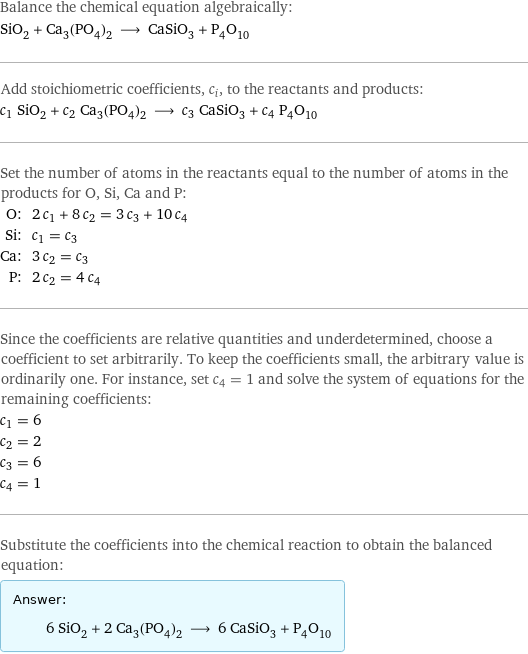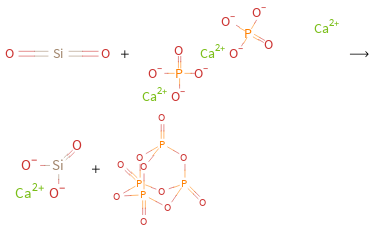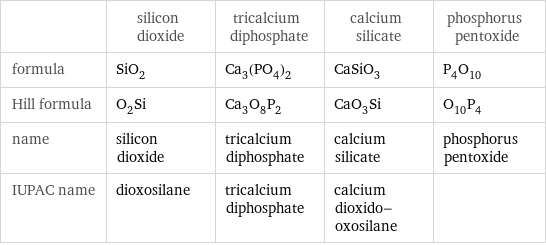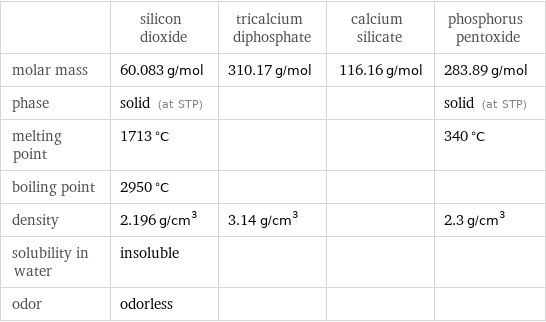Input interpretation

SiO_2 silicon dioxide + Ca_3(PO_4)_2 tricalcium diphosphate ⟶ CaSiO_3 calcium silicate + P_4O_10 phosphorus pentoxide
Balanced equation

Balance the chemical equation algebraically: SiO_2 + Ca_3(PO_4)_2 ⟶ CaSiO_3 + P_4O_10 Add stoichiometric coefficients, c_i, to the reactants and products: c_1 SiO_2 + c_2 Ca_3(PO_4)_2 ⟶ c_3 CaSiO_3 + c_4 P_4O_10 Set the number of atoms in the reactants equal to the number of atoms in the products for O, Si, Ca and P: O: | 2 c_1 + 8 c_2 = 3 c_3 + 10 c_4 Si: | c_1 = c_3 Ca: | 3 c_2 = c_3 P: | 2 c_2 = 4 c_4 Since the coefficients are relative quantities and underdetermined, choose a coefficient to set arbitrarily. To keep the coefficients small, the arbitrary value is ordinarily one. For instance, set c_4 = 1 and solve the system of equations for the remaining coefficients: c_1 = 6 c_2 = 2 c_3 = 6 c_4 = 1 Substitute the coefficients into the chemical reaction to obtain the balanced equation: Answer: | | 6 SiO_2 + 2 Ca_3(PO_4)_2 ⟶ 6 CaSiO_3 + P_4O_10
Structures

+ ⟶ +
Names

silicon dioxide + tricalcium diphosphate ⟶ calcium silicate + phosphorus pentoxide
Equilibrium constant
![Construct the equilibrium constant, K, expression for: SiO_2 + Ca_3(PO_4)_2 ⟶ CaSiO_3 + P_4O_10 Plan: • Balance the chemical equation. • Determine the stoichiometric numbers. • Assemble the activity expression for each chemical species. • Use the activity expressions to build the equilibrium constant expression. Write the balanced chemical equation: 6 SiO_2 + 2 Ca_3(PO_4)_2 ⟶ 6 CaSiO_3 + P_4O_10 Assign stoichiometric numbers, ν_i, using the stoichiometric coefficients, c_i, from the balanced chemical equation in the following manner: ν_i = -c_i for reactants and ν_i = c_i for products: chemical species | c_i | ν_i SiO_2 | 6 | -6 Ca_3(PO_4)_2 | 2 | -2 CaSiO_3 | 6 | 6 P_4O_10 | 1 | 1 Assemble the activity expressions accounting for the state of matter and ν_i: chemical species | c_i | ν_i | activity expression SiO_2 | 6 | -6 | ([SiO2])^(-6) Ca_3(PO_4)_2 | 2 | -2 | ([Ca3(PO4)2])^(-2) CaSiO_3 | 6 | 6 | ([CaSiO3])^6 P_4O_10 | 1 | 1 | [P4O10] The equilibrium constant symbol in the concentration basis is: K_c Mulitply the activity expressions to arrive at the K_c expression: Answer: | | K_c = ([SiO2])^(-6) ([Ca3(PO4)2])^(-2) ([CaSiO3])^6 [P4O10] = (([CaSiO3])^6 [P4O10])/(([SiO2])^6 ([Ca3(PO4)2])^2)](../image_source/d829986d8bf2ad20acf53e62a7ef64f9.png)
Construct the equilibrium constant, K, expression for: SiO_2 + Ca_3(PO_4)_2 ⟶ CaSiO_3 + P_4O_10 Plan: • Balance the chemical equation. • Determine the stoichiometric numbers. • Assemble the activity expression for each chemical species. • Use the activity expressions to build the equilibrium constant expression. Write the balanced chemical equation: 6 SiO_2 + 2 Ca_3(PO_4)_2 ⟶ 6 CaSiO_3 + P_4O_10 Assign stoichiometric numbers, ν_i, using the stoichiometric coefficients, c_i, from the balanced chemical equation in the following manner: ν_i = -c_i for reactants and ν_i = c_i for products: chemical species | c_i | ν_i SiO_2 | 6 | -6 Ca_3(PO_4)_2 | 2 | -2 CaSiO_3 | 6 | 6 P_4O_10 | 1 | 1 Assemble the activity expressions accounting for the state of matter and ν_i: chemical species | c_i | ν_i | activity expression SiO_2 | 6 | -6 | ([SiO2])^(-6) Ca_3(PO_4)_2 | 2 | -2 | ([Ca3(PO4)2])^(-2) CaSiO_3 | 6 | 6 | ([CaSiO3])^6 P_4O_10 | 1 | 1 | [P4O10] The equilibrium constant symbol in the concentration basis is: K_c Mulitply the activity expressions to arrive at the K_c expression: Answer: | | K_c = ([SiO2])^(-6) ([Ca3(PO4)2])^(-2) ([CaSiO3])^6 [P4O10] = (([CaSiO3])^6 [P4O10])/(([SiO2])^6 ([Ca3(PO4)2])^2)
Rate of reaction
![Construct the rate of reaction expression for: SiO_2 + Ca_3(PO_4)_2 ⟶ CaSiO_3 + P_4O_10 Plan: • Balance the chemical equation. • Determine the stoichiometric numbers. • Assemble the rate term for each chemical species. • Write the rate of reaction expression. Write the balanced chemical equation: 6 SiO_2 + 2 Ca_3(PO_4)_2 ⟶ 6 CaSiO_3 + P_4O_10 Assign stoichiometric numbers, ν_i, using the stoichiometric coefficients, c_i, from the balanced chemical equation in the following manner: ν_i = -c_i for reactants and ν_i = c_i for products: chemical species | c_i | ν_i SiO_2 | 6 | -6 Ca_3(PO_4)_2 | 2 | -2 CaSiO_3 | 6 | 6 P_4O_10 | 1 | 1 The rate term for each chemical species, B_i, is 1/ν_i(Δ[B_i])/(Δt) where [B_i] is the amount concentration and t is time: chemical species | c_i | ν_i | rate term SiO_2 | 6 | -6 | -1/6 (Δ[SiO2])/(Δt) Ca_3(PO_4)_2 | 2 | -2 | -1/2 (Δ[Ca3(PO4)2])/(Δt) CaSiO_3 | 6 | 6 | 1/6 (Δ[CaSiO3])/(Δt) P_4O_10 | 1 | 1 | (Δ[P4O10])/(Δt) (for infinitesimal rate of change, replace Δ with d) Set the rate terms equal to each other to arrive at the rate expression: Answer: | | rate = -1/6 (Δ[SiO2])/(Δt) = -1/2 (Δ[Ca3(PO4)2])/(Δt) = 1/6 (Δ[CaSiO3])/(Δt) = (Δ[P4O10])/(Δt) (assuming constant volume and no accumulation of intermediates or side products)](../image_source/7b75966757d745af3a22e7da24db0dd8.png)
Construct the rate of reaction expression for: SiO_2 + Ca_3(PO_4)_2 ⟶ CaSiO_3 + P_4O_10 Plan: • Balance the chemical equation. • Determine the stoichiometric numbers. • Assemble the rate term for each chemical species. • Write the rate of reaction expression. Write the balanced chemical equation: 6 SiO_2 + 2 Ca_3(PO_4)_2 ⟶ 6 CaSiO_3 + P_4O_10 Assign stoichiometric numbers, ν_i, using the stoichiometric coefficients, c_i, from the balanced chemical equation in the following manner: ν_i = -c_i for reactants and ν_i = c_i for products: chemical species | c_i | ν_i SiO_2 | 6 | -6 Ca_3(PO_4)_2 | 2 | -2 CaSiO_3 | 6 | 6 P_4O_10 | 1 | 1 The rate term for each chemical species, B_i, is 1/ν_i(Δ[B_i])/(Δt) where [B_i] is the amount concentration and t is time: chemical species | c_i | ν_i | rate term SiO_2 | 6 | -6 | -1/6 (Δ[SiO2])/(Δt) Ca_3(PO_4)_2 | 2 | -2 | -1/2 (Δ[Ca3(PO4)2])/(Δt) CaSiO_3 | 6 | 6 | 1/6 (Δ[CaSiO3])/(Δt) P_4O_10 | 1 | 1 | (Δ[P4O10])/(Δt) (for infinitesimal rate of change, replace Δ with d) Set the rate terms equal to each other to arrive at the rate expression: Answer: | | rate = -1/6 (Δ[SiO2])/(Δt) = -1/2 (Δ[Ca3(PO4)2])/(Δt) = 1/6 (Δ[CaSiO3])/(Δt) = (Δ[P4O10])/(Δt) (assuming constant volume and no accumulation of intermediates or side products)
Chemical names and formulas

| silicon dioxide | tricalcium diphosphate | calcium silicate | phosphorus pentoxide formula | SiO_2 | Ca_3(PO_4)_2 | CaSiO_3 | P_4O_10 Hill formula | O_2Si | Ca_3O_8P_2 | CaO_3Si | O_10P_4 name | silicon dioxide | tricalcium diphosphate | calcium silicate | phosphorus pentoxide IUPAC name | dioxosilane | tricalcium diphosphate | calcium dioxido-oxosilane |
Substance properties

| silicon dioxide | tricalcium diphosphate | calcium silicate | phosphorus pentoxide molar mass | 60.083 g/mol | 310.17 g/mol | 116.16 g/mol | 283.89 g/mol phase | solid (at STP) | | | solid (at STP) melting point | 1713 °C | | | 340 °C boiling point | 2950 °C | | | density | 2.196 g/cm^3 | 3.14 g/cm^3 | | 2.3 g/cm^3 solubility in water | insoluble | | | odor | odorless | | |
Units
